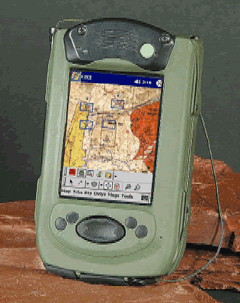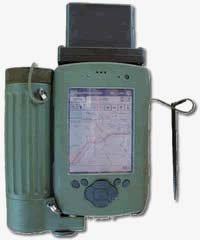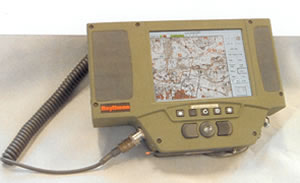CDA is an application built for militarized personal digital assistant (PDA), which provides situational awareness and mission planning capabilities for field commanders. The pocket PC application runs on a militarized version of an IPAQ, and is intended for the battalion commander and staff, company commanders and platoon leaders. CDA provides dismounted troops the same functionality of the US Army Battle Command, Brigade-and-Below (FBCB2) command and control system, which was sofar available only at stationary command posts or command vehicles. FBCB2 is the principal element in the “Blue Force Tracking” situational awareness system, and this is where CDA becomes a key element, as it integrates dismounted elements into the complete situational picture.
 In 2003 and early 2004, the U.S. Army initially deployed few systems for operational field testing. In 2004 and more significantly 2005, hundreds more CDAs (2005 models) will be deployed in support of dismounted troops in Iraq. The new model CDAs are based on the initial positive experience gained with earlier models. Due to the fast evolution of commercial PC and PDA technology, the Army is planning to deploy new versions of the system every year. The current version uses satellite phone capability and is able to download maps with overlaid graphics. For extended communications, the CDA is connected to a SINCGARS ASIP radio. Other radios may be incorporated in the future, such as the MBITR, the PRC-117F or L-band and Iridium satellite systems. The CDA is designed form automatic communication with other CDAs or supported communications devices, in a peer-to-peer formation. It can also operate in a network when required. Other communications features support “Blue Force Tracking” facility to support situational awareness of all friendly troops.
In 2003 and early 2004, the U.S. Army initially deployed few systems for operational field testing. In 2004 and more significantly 2005, hundreds more CDAs (2005 models) will be deployed in support of dismounted troops in Iraq. The new model CDAs are based on the initial positive experience gained with earlier models. Due to the fast evolution of commercial PC and PDA technology, the Army is planning to deploy new versions of the system every year. The current version uses satellite phone capability and is able to download maps with overlaid graphics. For extended communications, the CDA is connected to a SINCGARS ASIP radio. Other radios may be incorporated in the future, such as the MBITR, the PRC-117F or L-band and Iridium satellite systems. The CDA is designed form automatic communication with other CDAs or supported communications devices, in a peer-to-peer formation. It can also operate in a network when required. Other communications features support “Blue Force Tracking” facility to support situational awareness of all friendly troops.
In 2006, a new version of Commander’s Digital Assistant (CDA) was introduced by General Dynamics’ for the Land Warrior program. The system is currently available as Version 5, offering a larger color touch screen, hard disk, integral GPS and built-in satellite voice communications, offering the capability to exchange voice messaging with other CDAs. The system uses U.S. Army Standard Battle Command software to provide dismounted leaders with situational awareness picture, derived by FBCB2. The system also maintains constant position reporting for non-line-of-sight blue force tracking.
 The system enables battalion commanders to pass orders within their staff and migrate orders to company and platoon leaders. When deployed with dismounted teams, CDA is providing access to sensors, intelligence and tactical data not available in the past at such tactical levels. This capability is essential in low intensity warfare scenarios, where small forces must contain and manage situations before they escalate into crisis. Situational and intelligence displays also compute the center of mass for a particular units by the aggregation of its individual soldier’s positions, reported by GPS. For reporting, the system is equipped with joint variable message format (JVMF) database into the CDA system for open communications with other units, services and coalition forces.
The system enables battalion commanders to pass orders within their staff and migrate orders to company and platoon leaders. When deployed with dismounted teams, CDA is providing access to sensors, intelligence and tactical data not available in the past at such tactical levels. This capability is essential in low intensity warfare scenarios, where small forces must contain and manage situations before they escalate into crisis. Situational and intelligence displays also compute the center of mass for a particular units by the aggregation of its individual soldier’s positions, reported by GPS. For reporting, the system is equipped with joint variable message format (JVMF) database into the CDA system for open communications with other units, services and coalition forces.
At AUSA 2007 Raytheon unveiled some details about its Commander’s Digital Assistant (CDA). A product originally introduced as a ‘spin off’ from FCS has now evolved separately from the program. Raytheon is working on a new version of the Commander’s Digital Assistant (CDA). The new device establishes the smallest, lightest package currently available for dismounted ‘blue force tracking’ applications. The new device weighs 4.5 – 5.6 pounds (depending on configuration) using an internal, rechargeable 10.8 VDC Lithium-ion battery pack sustaining five hours of operation. CDA also offers improved commonality with the Army’s Air Warrior Electronic Data Manager.
 Further improving its application for aviators and ground troops, the new CDA is designed to be sunlight readable and compatible with night vision devices (ANVIS/NVG). CDA communicates with existing networks such as the FBCB2 or Interactive Situational Awareness System (ISAS), using an integral satellite communications L band transceiver and GPS receiver set with anti-spoofing capability (SAASM). Both antennae are combined into a single, external device. It will also interface smoothly with most tactical radios. Raytheon designed the CDA to integrate with its Microlight radio currently configured for the Enhanced Position Location Reporting System (EPLRS) waveform and tied into the tactical internet, carrying standard Joint Variable Message Format (JVNF) digital messages to users across the network. The system also supports Voice over IP communications. The CDA uses removable hard drive to ease data transfer and management of classified information. It runs on Linux RedHat or Windows 2000/XP operating systems.
Further improving its application for aviators and ground troops, the new CDA is designed to be sunlight readable and compatible with night vision devices (ANVIS/NVG). CDA communicates with existing networks such as the FBCB2 or Interactive Situational Awareness System (ISAS), using an integral satellite communications L band transceiver and GPS receiver set with anti-spoofing capability (SAASM). Both antennae are combined into a single, external device. It will also interface smoothly with most tactical radios. Raytheon designed the CDA to integrate with its Microlight radio currently configured for the Enhanced Position Location Reporting System (EPLRS) waveform and tied into the tactical internet, carrying standard Joint Variable Message Format (JVNF) digital messages to users across the network. The system also supports Voice over IP communications. The CDA uses removable hard drive to ease data transfer and management of classified information. It runs on Linux RedHat or Windows 2000/XP operating systems.



















